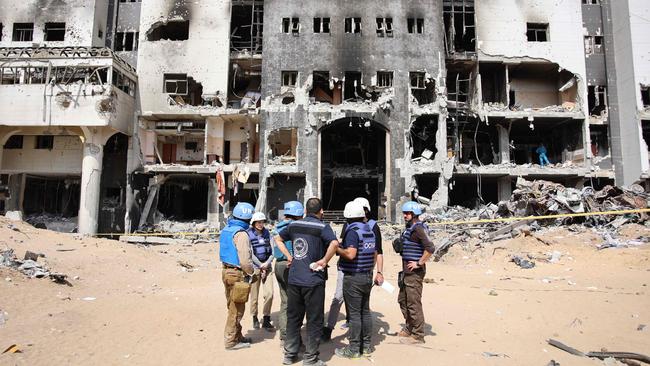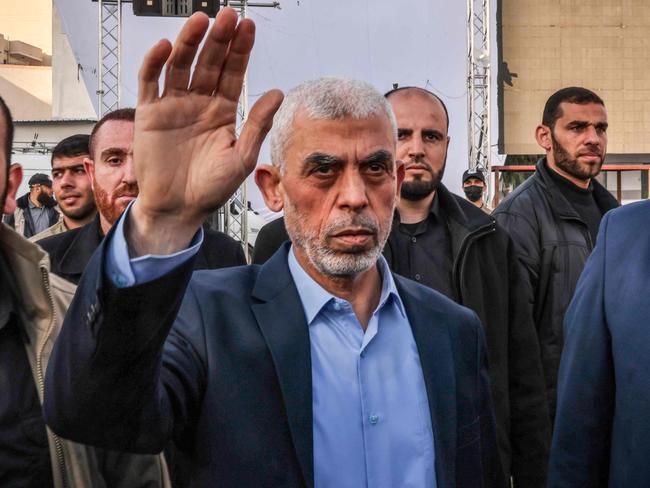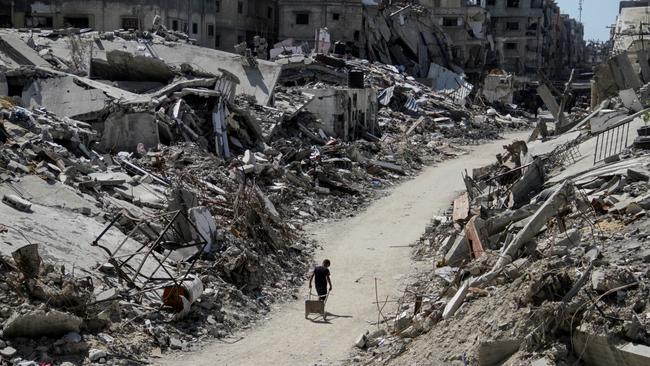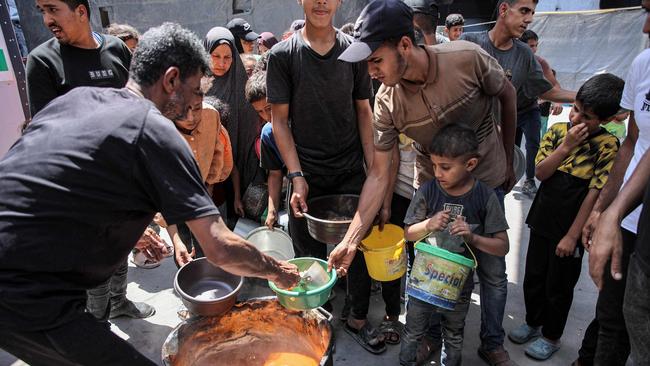Hamas propaganda wins spell disaster for Mid East
The people of Gaza truly are the casualties of lies that kill. And for so long as those lies are believed, the killing will never end.

What got lost when those claims were endlessly recycled in the left-leaning media, including our own ABC, was the obvious fact that it was Hamas that had put civilians at risk by imprisoning the hostages in a densely populated residential area. Nor was that unusual for Hamas: rarely in the long history of warfare have combatants made as much use of civilians as human shields as it has.
That civilians would get so caught up in the conflict was far from inevitable. It is true that Gaza’s major cities are highly populated, as are the refugee camps. But as Amnesty International has noted, “significant areas within the 365sq km of territory are not residential, and conducting hostilities or launching munitions from these areas presents a lower risk of endangering Palestinian civilians”.
Yet only a trivial share of Hamas’s attacks are launched from less densely populated areas; instead, they virtually all originate in the residential parts of the major urban centres.
And Hamas has gone even further than that, deliberately choosing facilities such as schools, childcare centres and hospitals – which are typically in or adjacent to housing complexes – as shelters for weapons and combatants, launching pads for drones and rockets, and command and control centres.

To make things worse, Hamas has repeatedly discouraged civilians from acting on Israel’s calls to evacuate places that are likely to become combat zones. Already in 2014, during Israel’s Operation Protective Edge, Sami Abu Zuhri, a high-ranking Hamas commander, urged Gazans to stay put rather than move in response to warnings.
More recently, as the current conflict got under way, the Hamas-run interior ministry sent text messages telling Gazans the Israeli warnings were merely intended “to frighten civilians”. Palestinians, Hamas said, should “act responsibly and not follow misleading Israeli instructions” – with that message and those that followed ensuring that thousands of civilians needlessly remained in harm’s way.

In part, Hamas’s reliance on human shields reflects its deeply entrenched cult of death. Gregor Ziemer, who served as the headmaster of the American School in Berlin from 1928 to 1939, described German schools in the Nazi era, where students were taught that “nothing is more glorious than to kill or be killed”, as “educating boys and girls for death”.
In exactly the same way, Hamas views civilian deaths not as a human tragedy but as a sign of strength. “Hamas despise those defeatist Palestinians that criticise the high number of civilian casualties,” said Abu Zuhri. “We lead our people to death … I mean, to war.”
As for Hamas leader Yahya Sinwar, he recently proclaimed that Palestinian deaths merely “infuse life into the veins of this nation, prompting it to rise to its glory and honour”. Palestinians, Hamas claims, “love martyrdom for the sake of Allah” and will continue to confront the “enemy until it vanishes from our entire land”.
But it is not just the cult of death that is at issue. Rather, as a NATO report on Hamas’s use of human shields in Gaza argues, Hamas’s unparalleled willingness to jeopardise Palestinian lives “is based on an awareness of Israel’s desire to minimise collateral damage”.
“If the Israel Defence Forces limits its use of military force in Gaza to avoid (that) damage,” says NATO, “Hamas will be less susceptible to Israeli attacks, and thereby able to protect its assets while continuing to fight.” Conversely, “If the IDF uses lethal force and causes an increase in civilian casualties, Hamas can utilise that as a lawfare tool: it can accuse Israel of committing war crimes, which could result in the imposition of a wide array of sanctions” – exactly as is now occurring.
Hamas is, in other words, exploiting the fact that Israel is far more vulnerable to international law than it is. There is, in effect, no doubt that using civilians as human shields is a war crime. To take but one example, article 57(1) to the Geneva Conventions specifies that “the civilian population or individual civilians shall not be used to render certain points or areas immune from military operations, in particular in attempts to shield military objectives from attacks or to shield, favour or impede military operations”.
But Hamas’s leaders are entirely unlikely to actually face war crimes proceedings, much less suffer any penalties for their conduct. On the contrary, says NATO, “Hamas uses the damage caused to civilians and civilian infrastructure as a justification to raise funds from donor nations”, directly or through NGOs, and “diverts the funds meant for reconstruction directly to its armed wing”. The fact that Israel, placed in a no-win situation, can be accused of unnecessarily harming civilians simply compounds the benefits Hamas derives.
All that starkly bears out the conclusion two distinguished experts on the law of armed conflict, William Boothby and Wolff Heintschel von Heinegg, reach in The Law of War (2018).
Far from “mitigating the evils of war”, they argue, the ever greater emphasis on avoiding civilian casualties has encouraged non-state combatants to “increasingly use civilian populations as shields or to otherwise favour their own military operations”. As a result, despite the best efforts of Western armed forces, “casualties among civilians in armed conflicts continue to rise unacceptably, both in absolute terms and as a proportion of total casualties” – with Hamas’s strategy, which other terrorist groups are sure to imitate, pushing the trend to an even higher level.

However, the success of Hamas’s strategy relies on more than the proliferating use of lawfare; as NATO notes, it also reflects “Western public opinion’s growing sensitivity towards civilian casualties”. There is, in that respect, a striking contrast to the campaign against the Vietnam War. That campaign certainly paid attention to the war’s civilian casualties, although it systematically ignored the communists’ role in bringing them about. But it did not take long for its intellectual gurus to deride what they called “corpse politics”.
Thus, in a highly influential critique of the initial moratorium, Susan Sontag argued that “visual representations of suffering have become cliche”, with the advent of TV making viewers, who were “bombarded by sensationalist photography”, inured to shocking images. Instead, what young people craved was heroes – and soon enough the narrative of the heroic guerrilla, variously epitomised by Che Guevara and Ho Chi Minh, displaced the denunciation of mass slaughter as the left’s rallying cry.
But at least in the West it is not easy, after the atrocities that were committed on October 7, to depict Hamas in glowing terms. Moreover, Western societies – and most of all the so-called progressives – no longer exalt heroism; rather, they worship at the shrine of victimhood. No one has better understood that change, or more skilfully used the digital environment to take advantage of it, than Hamas.
It fully grasps the media’s insatiable demand for graphic footage: as Sinwar told an Italian journalist in 2018, “We make the headlines only with blood – no blood, no news.” To that end, it deploys “journalists” who, like Muhammad Wishah, Ismail Abu Omar and Mustafa Thuraya, double as senior Hamas operatives and stringers for, or employees of, Al Jazeera, to selectively record incidents in which there are civilian casualties, immediately transmitting them worldwide as “evidence” of Israeli atrocities.
And by the time the IDF can correct the record, those claims have been echoed by scores of keffiyeh-clad radicals and given a degree of credibility by senior members of Western governments, including, on several occasions, our own. But Hamas also knows that not all of the world shares the West’s self-loathing addiction to victimhood – and it tailors its propaganda accordingly. Its reporting of the fighting at Gaza’s Al-Shifa Hospital – which Hamas used to store weapons, operate a command and control centre and hold hostages – is a case in point.
In Arabic, its social media posts glorified the gunbattles, highlighting the “heroism” and “Jihadi spirit” of the fighters it had inside the hospital complex. In contrast, its English-language posts, which were predictably relayed by the ABC, simply denied that there were any Hamas gunmen at the hospital and portrayed the Israeli operation as a cruel assault on a purely civilian target.
The trouble is that Hamas’s tactics work. Machiavelli, who regarded deliberate misinformation as an indispensable part of statesmanship and admired Ferdinand I of Spain and Pope Alexander VI for the effortless skill with which they lied, would scarcely have been surprised. Great pretenders, he wrote in The Prince, will invariably get the better of the simple-minded, and the astute deceiver will “always find someone who will allow himself to be deceived”.
Machiavelli also thought a state whose rulers were vulnerable to being duped was doomed to be destroyed. Perhaps that is where we now are in the West.
But the immediate tragedy is that the success of Hamas’s propaganda spells disaster for the people of the Middle East – including the people of Gaza.
They truly are the casualties of lies that kill. And for so long as those lies are believed, the killing will never end.





Just as Israelis gathered to celebrate the freeing of four hostages, Hamas’s propaganda machine went into overdrive, churning out claims that hundreds of civilians had been killed in the daring rescue operation.